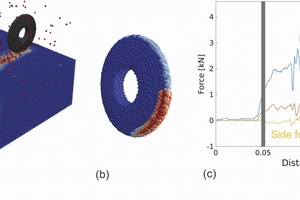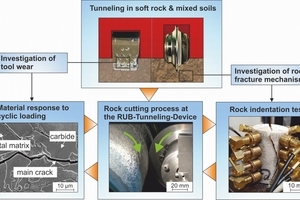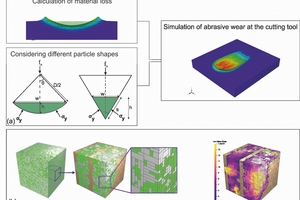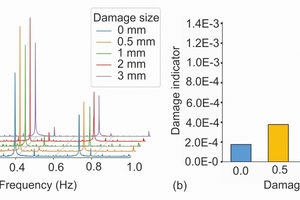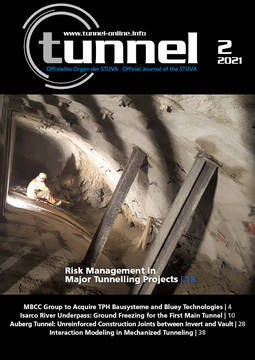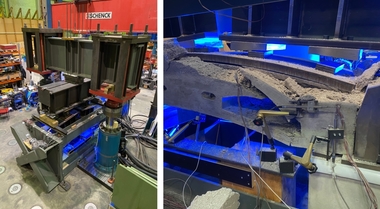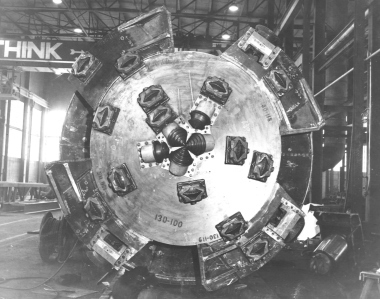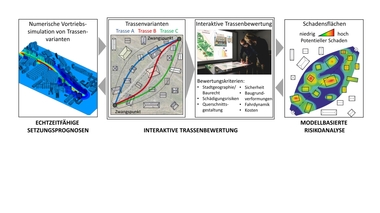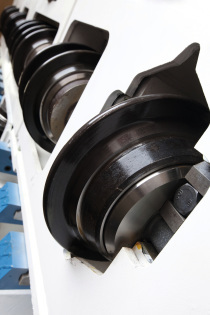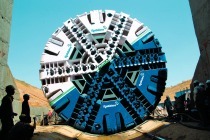Soil Excavation and Tool Wear
The wear of tunnelling tools successively reduces their excavation capability, which slows down the penetration rate of the tunnel-boring machine (TBM) and eventually requires a replacement of the tunnelling tools. Within the framework of the SFB 837, tool wear in soft rock and mixed grounds is being investigated, and on this basis, methods are being developed to increase the lifetime of tunnelling tools and predict tool wear.
1 Simulation of Processes at the
Cutting Disc
Tunnelling in heterogeneous ground exposes the cutting discs of TBMs to a rapid change of the forces when they transit from soft to hard components, causing cyclic loading. These load changes may eventually lead to excessive wear and premature failure. Within the framework of the SFB 837 a numerical model for the analysis of cutting discs of a TBM working in mixed ground is being developed. The model is used to simulate full-scale rock cutting tests as well as small-scale indentation tests and the computed forces are compared with experiments from the Colorado School of Mines [1] and self-conducted experiments. The validated model is employed to investigate the efficiency of different cutting tool geometries working in various rock types, such as soft soil to hard rock (Fig. 1a) or soft/weathered rock to hard rock transitions. In addition, the model is capable of predicting the volume loss at the cutting disc due to abrasive wear (Fig. 1b) resulting from highly varying cutting forces (Fig. 1c).
2 Interaction between Tunnelling Tools and Rocks during Tunnelling
To counteract tool wear, it is mandatory to identify the dominant wear mechanisms in the present ground conditions. With the RUB-Tunnelling-Device (Fig. 2), installed at the Chair of Materials Engineering at the Ruhr University Bochum it is possible to investigate the wear of cutting discs and to evaluate the applicability of different material concepts. In soft rock and mixed soils, which subject the tunnelling tools to cyclic loading, the fatigue of wear-protective layers, made of cemented carbides or hard alloys, may cause premature tool failure. With these investigations, the influence of type, volume content, and morphology of hard phases on the crack propagation can be understood [2]. Aside from tool wear, a comprehensive understanding of the failure mechanism of rocks, interacting with cutting tools, is crucial for tunnelling efficiency. Indentation tests on samples of intermediate-strength rocks are performed, during which the fracture process is monitored by acoustic-emission technique (Fig. 2). By using different test parameters and rock types, various rock cutting scenarios can be simulated.
3 Multiscale Modelling, Simulation
and Optimization of Tunnelling Tools Regarding Their Tribological Behaviour
It is necessary to model the wear of mining tools on macroscopic and microscopic scales to obtain a deeper understanding of the processes like abrasion and surface spalling. Therefore, we develop a coupled damage-plasticity material model, to be used for simulation of material loss due to abrasion with an erosion algorithm controlled by damage parameters. The investigation of elastoplastic contacts between the single abrasive particle and the different cutting tools, such as chisel and cutting discs, is achieved by modelling the single scratch test (Fig. 3a) [3]. Particles with different shapes and sizes are considered and the results will be calibrated with the experiments and microscale simulations. The second wear mechanism, surface spalling, is investigated by simulating the crack propagation through the microstructure of hard composites, based on micro-CT scans (Fig. 3b) [4]. This permits lifetime predictions for tunnelling tools and suggestions for the improvement of their wear resistance.
4 Vibration-Based Monitoring of Interactions at the Cutting Disc – Detecting Wear
Relatively few investigations are devoted to the development of a condition monitoring (CM) system for cutting tools in the light of the enormous efforts involved in operating a TBM and the high costs related to unplanned maintenance activities due to the failure of cutting discs. Maintenance intervals for cutting discs of TBMs are currently based on experience rather than the assessment of the cutting tools using monitoring data [5]. We establish the foundation for such a CM system by using damage- and natural frequencies to detect defects and fatigue [6]. Experiments with the RUB-Tunnelling-Device (Fig. 2) show that defects in cutting discs can be found even when sensors are not directly attached to the cutting disc. With advanced data analysis, a spectral feature in frequency domain was extracted showing a high correlation to defect size (Fig. 4), which allows for detailed damage assessment [7].

